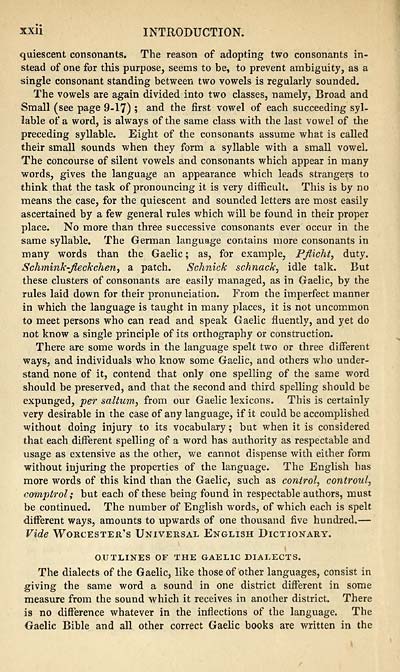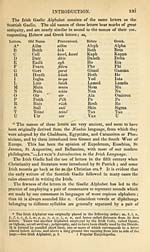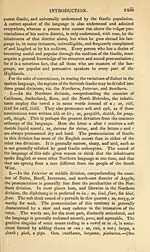Books and other items printed in Gaelic from 1841 to 1870 > Stéidhean a' Ghràmair Ghaëlig
(26) Page xxii
Download files
Complete book:
Individual page:
Thumbnail gallery: Grid view | List view

xxu
INTRODUCTION.
quiescent consonants. The reason of adopting two consonants in-
stead of one for this purpose, seems to be, to prevent ambiguity, as a
single consonant standing between two vowels is regularly sounded.
The vowels are again divided into two classes, namely, Broad and
Small (see page 9-17) ; and the first vowel of each succeeding syl-
lable of a word, is always of the same class with the last vowel of the
preceding syllable. Eight of the consonants assume what is called
their small sounds when they form a syllable with a small vowel.
The concourse of silent vowels and consonants which appear in many
words, gives the language an appearance which leads strangers to
think that the task of pronouncing it is very difficult. This is by no
means the case, for the quiescent and sounded letters are most easily
ascertained by a few general rules which will be found in their proper
place. No more than three successive consonants ever occur in the
same syllable. The German language contains more consonants in
many words than the Gaelic ; as, for example, Pflicht, duty.
Sch mink- fleckchen , a patch. Schnick schnack, idle talk. But
these clusters of consonants are easily managed, as in Gaelic, by the
rules laid down for their pronunciation. From the imperfect manner
in which the language is taught in many places, it is not uncommon
to meet persons who can read and speak Gaelic fluently, and yet do
not know a single principle of its orthography or construction.
There are some words in the ianguage spelt two or three different
ways, and individuals who know some Gaelic, and others who under-
stand none of it, contend that only one spelling of the same word
should be preserved, and that the second and third spelling should be
expunged, per saltum, from our Gaelic lexicons. This is certainly
very desirable in the case of any language, if it could be accomplished
without doing injury to its vocabulary ; but when it is considered
that each different spelling of a word has authority as respectable and
usage as extensive as the other, we cannot dispense with either form
without injuring the properties of the language. The English has
more words of this kind than the Gaelic, such as control, controul,
comptrol; but each of these being found in respectable authors, must
be continued. The number of English words, of which each is spelt
different ways, amounts to upwards of one thousand five hundred. —
Vide Worcester's Universal English Dictionary.
OUTLINES OF THE GAELIC DIALECTS.
The dialects of the Gaelic, like thoseof other languages, consist in
giving the same word a sound in one district different in some
measure from the sound which it receives in another district. There
is no difference whatever in the inflections of the language. The
Gaelic Bible and all other correct Gaelic books are written in the
INTRODUCTION.
quiescent consonants. The reason of adopting two consonants in-
stead of one for this purpose, seems to be, to prevent ambiguity, as a
single consonant standing between two vowels is regularly sounded.
The vowels are again divided into two classes, namely, Broad and
Small (see page 9-17) ; and the first vowel of each succeeding syl-
lable of a word, is always of the same class with the last vowel of the
preceding syllable. Eight of the consonants assume what is called
their small sounds when they form a syllable with a small vowel.
The concourse of silent vowels and consonants which appear in many
words, gives the language an appearance which leads strangers to
think that the task of pronouncing it is very difficult. This is by no
means the case, for the quiescent and sounded letters are most easily
ascertained by a few general rules which will be found in their proper
place. No more than three successive consonants ever occur in the
same syllable. The German language contains more consonants in
many words than the Gaelic ; as, for example, Pflicht, duty.
Sch mink- fleckchen , a patch. Schnick schnack, idle talk. But
these clusters of consonants are easily managed, as in Gaelic, by the
rules laid down for their pronunciation. From the imperfect manner
in which the language is taught in many places, it is not uncommon
to meet persons who can read and speak Gaelic fluently, and yet do
not know a single principle of its orthography or construction.
There are some words in the ianguage spelt two or three different
ways, and individuals who know some Gaelic, and others who under-
stand none of it, contend that only one spelling of the same word
should be preserved, and that the second and third spelling should be
expunged, per saltum, from our Gaelic lexicons. This is certainly
very desirable in the case of any language, if it could be accomplished
without doing injury to its vocabulary ; but when it is considered
that each different spelling of a word has authority as respectable and
usage as extensive as the other, we cannot dispense with either form
without injuring the properties of the language. The English has
more words of this kind than the Gaelic, such as control, controul,
comptrol; but each of these being found in respectable authors, must
be continued. The number of English words, of which each is spelt
different ways, amounts to upwards of one thousand five hundred. —
Vide Worcester's Universal English Dictionary.
OUTLINES OF THE GAELIC DIALECTS.
The dialects of the Gaelic, like thoseof other languages, consist in
giving the same word a sound in one district different in some
measure from the sound which it receives in another district. There
is no difference whatever in the inflections of the language. The
Gaelic Bible and all other correct Gaelic books are written in the
Set display mode to:
![]() Universal Viewer |
Universal Viewer | ![]() Mirador |
Large image | Transcription
Mirador |
Large image | Transcription
Images and transcriptions on this page, including medium image downloads, may be used under the Creative Commons Attribution 4.0 International Licence unless otherwise stated. ![]()
| Rare items in Gaelic > Books and other items printed in Gaelic from 1841 to 1870 > Stéidhean a' Ghràmair Ghaëlig > (26) Page xxii |
|---|
| Permanent URL | https://digital.nls.uk/101711911 |
|---|
| Description | Out-of-copyright books printed in Gaelic between 1631 and 1900. Also some pamphlets and chapbooks. Includes poetry and songs, religious books such as catechisms and hymns, and different editions of the Bible and the Psalms. Also includes the second book ever published in Gaelic in 1631. |
|---|

